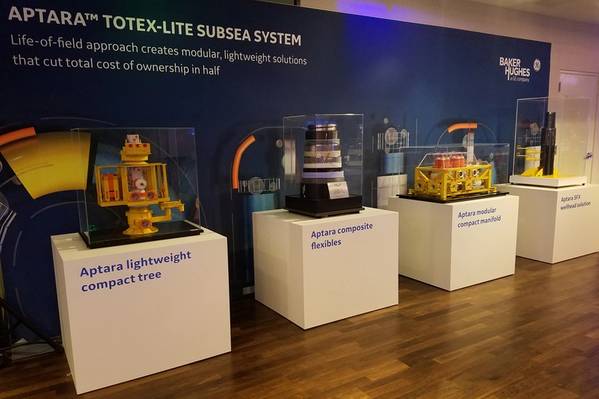
New lightweight, modular subsea technologies could reduce not just lead times for equipment delivery but lower the total cost of ownership for the full life of the field.
Baker Hughes, a GE company, revealed its thinking on subsea developments during the launch event in Houston earlier this week. The Subsea Connect system is centered around Project Connect, reservoir to topside technology solutions, flexible partnerships and commercial models and digital enablement, and BHGE believes the combination of these four pillars can reduce the economic development cost of subsea projects by an average of 30 percent.
Neil Saunders, president & CEO of BHGE’s Oilfield Equipment business, says that price reduction could make a marginal asset attractive for development and improve the economics of one that already meets breakeven requirements.
Historically, said Graham Gillies, BHGE vice president for subsea, the subsea portion of a field can claim 30 percent to 50 percent of the project development costs.
The downturn of the industry forced rounds of cost-cutting measures, with many subsea vendors bringing prices for technology and equipment down by about 30 percent and thereby driving down the breakeven price for projects.
“But that 30 percent is not enough. We needed to do more,” Saunders said.
As a result, BHGE looked at different ways to further lower costs. The answer, Saunders said, lay in removing costs at an opex level over the life of the field, rather than purely during the capex portion of a project. The result was Subsea Connect, which he said the company believes will make a “long-lasting, sustainable change and driving value from concept to commissioning and over the full life of field.”
A major component of that is the newly revealed Aptara TOTEX-lite subsea system, which includes the lightweight compact tree, modular compact manifold, composite flexible risers, SFX wellhead solution, modular compact pump and subsea connection systems.
The Aptara technologies are modular, structured, compact and designed to be more responsive to changing conditions across the life of field, cutting total cost of ownership by up to 50 percent. For example, at the outset of a field’s productive life, a high-integrity pressure protection system (HIPPS) tree cap may be required, but eventually the field will need a standard production tree cap, then a boosting tree cap, Saunders said. That equipment may be there for the entire life of the well, even though it is not needed during the entire productive life of the well, he added.
With the modular Aptara subsea system, Saunders said, first a HIPPS tree cap can be placed on the wellhead, and it can be removed and replaced with the production tree cap, then the boosting tree cap as the well’s production stream changes. The Aptara subsea system can contribute up to 50 percent cost saving over the total cost of ownership, he said.
The Aptara system fits under the reservoir to topsides technology solutions pillar, which draws on BHGE’s fullstream capability to offer reservoir management, field development, well construction, topside optimization and subsea engineering. With Project Connect, BHGE helps customers target specific project outcomes and increase speed to financial investment decision.
The third component – using flexible partnerships and commercial models – is designed to leverage relationships with partners to improve project economics.
Digital enablement is aimed at driving uptime and enhancing productivity. BHGE’s engageSubsea asset lifecycle management solution, for example, could drive up to a 20 percent reduction in maintenance costs, and up to a 5 percent reduction in downtime through predictive analytics.
“We’re already delivering against Subsea Connect,” Saunders said, noting the company has invested significantly in structuring its subsea production systems portfolio to ensure shorter lead times and quicker responses. “We have also signed an agreement with a major operator to provide the Aptara lightweight compact tree for deployment next year.”